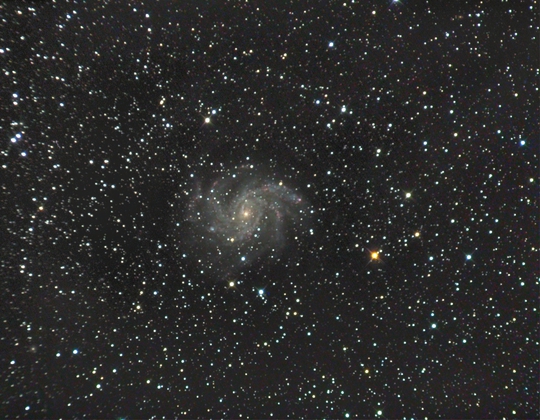-
December 2015 - Galaxy of the Month
NGC 691 Group in Aries
This interactive image of the NGC 691 group was provided by the Sloan Digital Sky Survey using Aladin Sky Atlas.
The NGC 691 group is a collection of 9 galaxies consisting of NGC 678, 680, 691, 694, 695 and NGC 695 along with IC 1730 and IC 167.
The group is spread over quite a wide area with almost a degree spanning NGC 691 and 695. The core of the group is centred around NGC 691, 678, 680 and NGC 694. NGC 678 and 680 were discovered in William Herschel in 1784 but it was two years later in 1786 before he found 691. Heinrich d’Arrest found NGC 694 in 1861 as it is much fainter than the others. Perhaps unusually for an IC object Bigourdan found IC 167 using a 12” refractor in 1889.
The whole group is spread around the bright double star 1 Ari. This may make it more difficult to see than it should be.
The group is about 122 million ly from us which is relatively close by and explains the large angular spread of the group on the sky.
NGC691 was home to SN 2005W, although it only reached magnitude 15.2.
Both NGC 691 and NGC 678 feature in the Webb Deep-Sky Society Observer's Handbook (WSDSOH) Volume 4 where both are described as brightish in a 16” telescope.
Night Sky Observer's Guide (NSOG) reports the two brighter members as easy in 22cm and the others as more challenging.
Interestingly most of the galaxies are spirals or lenticulars with only NGC 680 a confirmed elliptical, and a peculiar one at that as it shows signs of recent interactions or mergers with a number of shells. NGC 680 also appears to be interacting with NGC 678 as well.
There is an interesting amateur image of the whole group at Astrophotography by Alson Wong.
Split away from the main group on the other side of 1 Ari are NGC 697 and 695. NGC 697 is a nice bright spiral but NGC 695 is much fainter and although catalogued as a double galaxy its faintness suggests it might not actually be a member of the group. Its recession velocity from NED, if correct, is 3 times greater than the others in the group. It certainly appears in front of a field of much fainter galaxies. There also appears to be some confusion over the identity of NGC 697 with Harold Corwin suggesting it is actually NGC 674 and d’Arrest was confused and saw the same object twice.
The Megastar chart with this does not identify IC 1730, so there is a second more detailed chart from SkyTools that does.
Owen Brazell - Galaxy Section Director
-
June 2011 - Galaxy of the Month
NGC 6946

Image Courtesy of Dietmar Hager - Linz, Austria. Click on image for a larger version. For more images from Dietmar please visit his website.
The summer is perhaps not the best known season for galaxies but even in constellations better known for nebulae and clusters there are still some bright examples. NGC 6946 on the Cygnus /Cepheus border, better known as the Firecracker galaxy from the number of supernovae that have appeared in it, is one of these.
First discovered by William Herschel in 1798, NGC 6946 is a face on spiral, not dissimilar to M101, which I think would be better known if it was not suffering 1.6 magnitudes of extinction from within our own galaxy. Once believed to be a member of our local group NGC 6946 is now thought to be at a distance of 6.5 Mpc (20 million light years) and as such outside the gravitational radius of the local group. There does appear however to be quite a spread in the distance measurements with a number of sources suggesting it may be as close as 10 million light years (3 Mpc).
NGC 6946 appears to be undergoing a burst of star formation which is unusual in isolated galaxies because these are often triggered by interactions with other galaxies. As far as we can tell NGC 6946 does not appear to be associated with any other galaxy groups. This burst of star formation is probably also the reason that 6 supernovae have been seen in NGC 6946 over the last 100 years or so. NGC 6543 also contains a nuclear star burst which recent observations suggest may well be associated with the formation of a bar in the core of the galaxy.
The morphological classification of NGC 6946 is SAB (rs)cd, relating to its barred spiral nature The magnitude of the galaxy varies with waveband and a blue magnitude of 9.6 is listed in NED. Various sources however give NGC 6946 a visual magnitude of around 8.9. Despite this bright integrated magnitude NGC 6946 has a very low surface brightness due to its size (11.6’ x 9.8’) and it will be likely that a 22cm scope will be required to show any details of the spiral arms at all. Smaller aperture telescopes will show a faint haze and the core. Indeed it does look like a faint globular cluster. Larger instruments should be able to pick out the spiral arms and some of the HII regions that line them. The included finder chart shows some of these regions. A low power field may also show the cluster NGC 6939 to the North west and observers with large telescopes may be able to pick out the edge on galaxy UGC 11583 nearby as well.
Owen Brazell - Galaxy Section Director